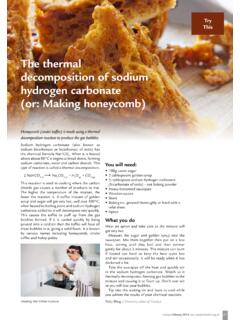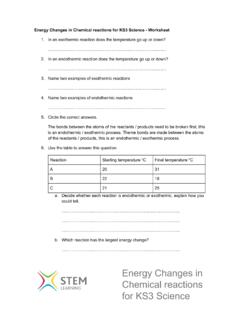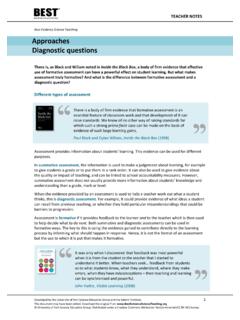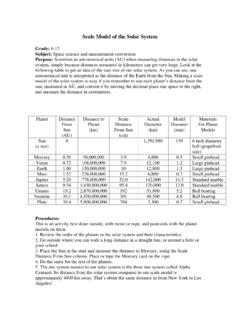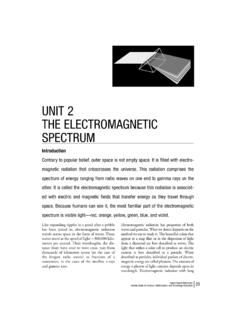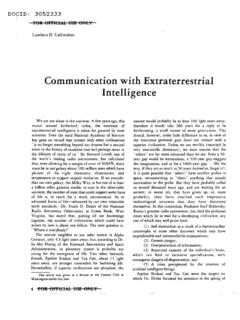Transcription of OUR SOLAR SYSTEM
1 Primary | PR01. teach with space OUR SOLAR SYSTEM . Journey to other celestial objects teacher s guide and pupil activities INTRODUCTION. Our SOLAR SYSTEM consists of the Sun, eight planets, their moons and many smaller bodies called asteroids and comets. This fun and creative research project allows pupils to discover our closest neighbours in space and develop their communication skills by sharing their work with the class. Fast facts page 3. Background page 4. Activity - our SOLAR SYSTEM page 9. Introducing our SOLAR SYSTEM page 9. Collecting information page 11. Classroom discussion page 11. Suggested extension activities page 12. The order of the planets - mnemonics page 12. Order the planets game page 12. Conclusion page 13. Worksheet page 14. Space context @ ESA page 18. Giotto page 18. Rosetta page 18. Appendix page 20. SOLAR SYSTEM game cards page 20. Links page 22. 2. teach with space - our SOLAR SYSTEM | PR01.
2 OUR SOLAR SYSTEM . Journey to other celestial objects FAST FACTS Outline Age range: 8 - 11 years old In this activity, pupils will work in groups to research the different objects (the eight Type: pupil (group) activity planets, comets and asteroids) in our SOLAR SYSTEM . Each group will research one object Complexity: easy and produce a fact sheet. At the end of the activity, the different groups present their Teacher preparation time: 1 hour (including findings to the class and combine the fact visit to the library) sheets into a class encyclopedia. Lesson time required: - 2 hours Pupils will learn Cost: low (less than 10 euro) 1. Which planets have moons. 2. Which planets have rings. Location: indoor (any classroom) 3. The colours of the different planets. 4. What a moon is. Includes the use of: reference books & 5. What a ring of a planet is. magazines, craft materials, the internet (optional) 6. To work together.
3 Curriculum relevance Science Formal presentations and debates Classifying objects Read and discuss reference books and Movement of planets in the SOLAR SYSTEM textbooks Movement of the Moon relative to Earth Develope pupils vocabulary Shape of SOLAR SYSTEM objects Learn to read silently The Sun is a star Justify views about what they have read Composition Retrieve, record and present information Literacy from non-fiction Ask relevant questions to extend their understanding and knowledge Give well-structured descriptions, Art & design explanations and narratives for different Use a variety of materials & techniques purposes Use drawing/painting etc to develop and Maintain attention and participate actively share ideas in collaborative conversations Speak audibly and fluently teach with space - our SOLAR SYSTEM | PR01 3. BACKGROUND. The planets Our SOLAR SYSTEM formed about billion years ago from a large cloud of gas and dust called a nebula.
4 At the centre is our closest star, the Sun. Orbiting around the Sun are eight planets. In order from the closest to the Sun they are: Mercury, Venus, Earth, Mars, Jupiter, Saturn, Uranus and Neptune The planets can be placed into two distinct groups. The four planets closest to the Sun are small and rocky and are often referred to as the inner, or terrestrial, planets (Figure 1). The outer four planets are much larger and very cold. These are the giant planets (Figure 2). Jupiter and Saturn are known as the gas giants. Uranus and Neptune are referred to as the ice giants. Figure 1. M. P rez-Ay car & C. Wilson team Heritage Team (STScI/AURA), J. Bell, and M. Wolff ESA/MPS/DLR/IDA,M. P rez-Ay car Hubble theOSIRIS. ESA/MPS/DLR/IDA, & C. Wilson NASA-APL. / Rosetta NASA-APL. NASA. ESAESA, Mercury Venus Earth Mars NASA. NASA, The inner (terrestrial) planets. The images shown here are not to scale. Figure 2. NASA/JPL/Space Science Institute NASA, ESA, and A.
5 Simon NASA/JPL. Jupiter Saturn Uranus Neptune DLR. The outer (giant) planets. The images shown here are not to scale. Rings All of the giant planets have rings. The most spectacular are Saturn's rings which are the largest in the SOLAR SYSTEM (Figure 2). Saturn's rings are made up of billions of small pieces of water ice with traces of rocky material. These pieces range in size from micrometres* to metres across. As the rings are mostly made of ice they reflect the Sun's light and are therefore bright and easy to observe. * Micrometre: A micrometre, or micron, is a tiny fraction of a metre (1 millionth of a metre). If 1 meter was equal to the length of one football field (~100 metres), 1 micrometre would be about the width of a human hair. teach with space - our SOLAR SYSTEM | PR01 4. The rings around Jupiter, Uranus and Neptune are much smaller, darker and fainter than the rings around Saturn. They are also made of very different material.
6 The rings of Jupiter and Neptune contain a lot of tiny dust particles. The rings of Uranus consist of larger material, typically around 20 centimetres to 20. metres across. The darkest ring systems are around Uranus and Neptune. The very dark colour of these rings is due to the kind of material they are made of. Moons As well as the planets, there are many smaller objects in the SOLAR SYSTEM . The most well known group of small objects are moons. A moon is an object that orbits a planet and accompanies the planet on its own orbit around the Sun. Not all planets have a moon. Everyone is familiar with Earth's Moon that is clearly visible in the sky. The other planets with moons are Mars, Jupiter, Saturn, Uranus and Neptune. Some moons are large and spherical like Earth's Moon, such as the four largest moons of Jupiter (the Galilean moons Io, Europa, Ganymede and Callisto; see Figure 3). These moons are thought to have formed alongside their parent planets.
7 Many other moons, such as the two moons of Mars (Phobos and Deimos), are smaller and have a more irregular shape. Smaller moons, like those of Mars, are thought to be asteroids which were captured' by the planet at a later time (Figure 3). Figure 3. ESA/DLR/FU Berlin (G. Neukum). NASA/JPL-Caltech Gregory H. Revera Moon Europa Io Callisto Ganymede Phobos Examples of moons in the SOLAR SYSTEM . The images shown here are not to scale. Asteroids Asteroids are a group of small, irregular-shaped bodies located in the inner SOLAR SYSTEM . Asteroids are made of rocky and metallic material, such as iron. There are millions of asteroids in the SOLAR SYSTEM . The majority of asteroids orbit the Sun in the Asteroid Belt between the orbits of Mars and Jupiter. Asteroids are thought to be material left over from the formation of the SOLAR SYSTEM . The biggest asteroid, called Ceres, is around 950 km across. It is so big that it is almost spherical and is believed to be an embryonic planet that, billions of years ago, couldn't form fully due to the large size, and hence large gravitational pull, of nearby Jupiter.
8 The European Space Agency's Rosetta mission passed by and studied two asteroids, 21 Lutetia and 2867. Steins, on its long journey to a comet. Figure 4 is a montage of images of asteroids and comets to show the large variation in size and shape. 5. teach with space - our SOLAR SYSTEM | PR01. Figure 4. 243 Ida Dactyl 9969 Braille 5535 Annefrank 2867 Steins x x km [(243) Ida I] x 1 x 1 km x x km x km Galileo, 1993 x km Deep Space 1, 1999 Stardust, 2002 Rosetta, 2008. Galileo, 1993. 25143 Itokawa 433 Eros x x km 33 x 13 km Hayabusa, 2005. NEAR, 2000. 253 Mathilde 66 x 48 x 44 km NEAR, 1997. 951 Gaspra x x km Galileo, 1991 21 Lutetia 132 x 101 x 76 km Rosetta, 2010. 19P/Borrelly 9P/Tempel 1 81P/Wild 2 19/P/Halley 8 x 4 km x km km 6 x 8 x 8 km Deep Space 1, 2001 Deep Impact, 2005 Stardust, 2004 Vega 2, 1986. A composite showing the different shapes and sizes of asteroids and comets. The comets are the four objects at the bottom of the figure.
9 The text accompanying each image is: Line 1 - number and name of the object, Line 2 - dimensions in kilometres, Line 3 - name of the spacecraft that studied the object and the year in which the image was taken. Created from a montage by Emily Lakdawalla. Ida, Dactyl, Braille, Annefrank, Gaspra, Borrelly: NASA / JPL / Ted Stryk. Steins: ESA/ OSIRIS team. Eros: NASA / JHUAPL. Itokawa: ISAS / JAXA / Emily Lakdawalla. Mathilde: NASA / JHUAPL / Ted Stryk. Lutetia: ESA / OSIRIS team / Emily Lakdawalla. Halley: Russian Academy of Sciences / Ted Stryk. Tempel 1: NASA / JPL / UMD. Wild 2: NASA / JPL. 6. teach with space - our SOLAR SYSTEM | PR01. Comets Comets are small, icy worlds that originate from Figure 5. regions of the outer SOLAR SYSTEM , beyond the planet Neptune, known as the Kuiper Belt and the Oort Cloud. Comets are mostly made out of ice but also contain dust and rocky material. Just like asteroids, they are material left over from the formation of the SOLAR SYSTEM and have an irregular shape (Figure 4).
10 The majority of comets take hundreds or thousands of years to orbit the Sun - compare that to just one year for the Earth! Occasionally, the orbit of a comet can be changed sending it racing towards the inner SOLAR SYSTEM . As comets approach the Sun, they begin to heat up and sometimes produce spectacular tails of Philipp Salzgeber gas and dust (Figure 5). Many comets have very elongated orbits, which means that they are close to the Sun, and therefore visible, for only a short period of time. The orbits of some comets have Photo of the comet Hale-Bopp taken in Croatia. changed so significantly that they now orbit the Sun on much shorter timescales. Comet 1P/Halley orbits the Sun about every 75 years and has been recorded to be observed from Earth (with the naked eye) on a regular basis over the last thousand years or so. One famous record of comet 1P/Halley's visibility from Earth was made on the Bayeux Tapestry that depicts the Battle of Hastings in 1066 (Figure 6).
